Table of Contents
A compound inequality calculator displays the inequality equation with number line representation when given a compound inequality. In STUDYQUERIES’s online compound inequality calculator tool, the calculation is faster, and the inequality equation is displayed in just a few seconds.
How to Use the Compound Inequality Calculator?: Step By Step Guide
The procedure to use the compound inequality calculator is as follows:
- Step 1: Enter two inequality equations in the respective fields
- Step 2: Click the “Solve” button to get the inequality
- Step 3: The inequality equation with the number line will be displayed in a new window
Compound Inequality Calculator
What Is Compound Inequality And Compound Inequality Calculator?
The compound inequality is made up of two inequality statements connected either by the word “or” or by the word “and.” “And” indicates that both statements are true at the same time.
In other words, the solution sets for the individual statements overlap or intersect. “Or” indicates that if either statement is true, the entire compound sentence is true. This solution set is the combination or union of the solution sets for the individual statements.
The inequality that uses the word “and” is called a conjunction. While “and” and “or” are parts of speech known as conjunctions, the mathematical conjunction has a different meaning than the grammatical one.
In order to illustrate this point, the conjunction “or”, when used in a compound inequality, creates a disjunction. Remember that “con” means “with another” and “dis” means “one OR the other.”
Solving Methods Of Compound Inequalities
We will deal with two general types of compound inequalities when solving them.
- For the first problem, we must solve two linear inequalities connected by the word “and”. The conjunction “and” is also known as a conjunction. The solution of an “and” compound inequality is the set of all values of x that satisfy both the inequalities. In other words, you need a solution set that works with both inequalities. Another way of saying it is that the solution set of the “and” compound inequality is the intersection, represented by the symbol \(\Large{\Bbb \cap}\), of the two inequalities.
- In the second case, you must solve two linear inequalities that are connected by the word “or”. If there is an “or” compound inequality, the solution is the set of all x that satisfies one or both inequalities, or sometimes both at the same time. In other words, you want a solution that works on at least one inequality. It can also be said that the solution set of an “or” compound inequality is the union, represented by the symbol \(\Large{\Bbb \cup}\), of the two inequalities.
Both graphs on the number line as well as interval notation can be used to express the solutions of compound inequalities.
Integration By Parts Calculator
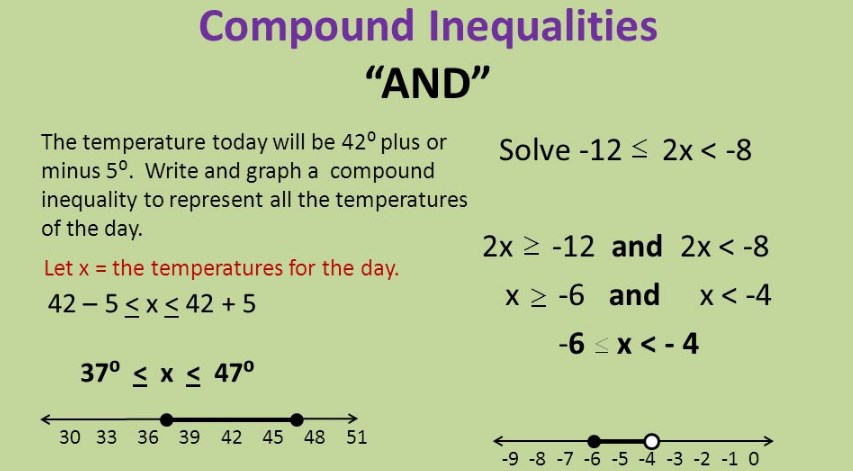
Prior to expressing the solution of the compound inequality in interval notation, you should graph the solutions of the two inequalities on the number line. With an understanding of how the two inequalities behave on the number line, it is much easier to write the interval notation.
Additionally, we will look at some examples where compound inequality has no solution or has an infinite solution.
We will discuss an “and” compound inequality case somewhere in our examples, which can be condensed into a single inequality with three parts: the left side, the middle part, and the right side. An example would be \(- 1 \le x \le 3\) which is derived from \(-1 \le x\) and \(x \le 3\). By writing it in this form, we can solve the compound inequality more quickly.
The “AND” Compound Inequalities
Solve the compound “and” inequality by solving each of the two inequalities separately, then look at their solutions together. For the “and” case, we want to find all the numbers or values that can make both inequalities true.
Solve the compound inequality \(x – 1 \gt 1\) and \(27 \ge 2x – 1\). Graph the solutions on the number line. Then, write your solutions in interval notation.
Step 1: Solve each inequality.
First inequality: \(x-1 \gt 1\)
Add 1 to each side of the inequality.
$$x – 1+1 \gt 1+1$$
$$\Bbb x \gt 2$$
Second inequality: \(27\ge 2x-1\)
Divide both sides of the inequality by 2 after adding both sides by 1. Make sure the variable is on the left. In this case, the variable x will move from left to right when you swap locations. In order to maintain the meaning of the inequality symbol, it should remain in the same relative orientation.
It can be seen that the “mouth” of the inequality symbol is opening towards the number 14. When you swap, the mouth of the inequality must still point towards 14.
$$27 \ge 2x – 1$$
$$27 + 1 \ge 2x – 1 + 1$$
$$28 \ge 2x$$
$$\frac{28}{2} \ge \frac{2x}{2}$$
$$14 \ge x$$
$$x \le 14$$
The solutions are given by \(\Bbb {x} \gt 2\) and \(\Bbb {x} \le 14\).
Step 2: Graph the solutions on the number line.
For \(x \gt 2\), point 2 is not included as part of the solutions since \(x \gt 2\) means all numbers greater than 2. Further, it does not have any conditions of equality, so we must exclude the number 2. An open circle will be placed over 2 to indicate that it is not a solution. We draw an arrow to the right of 2 because all the solutions are greater than 2.
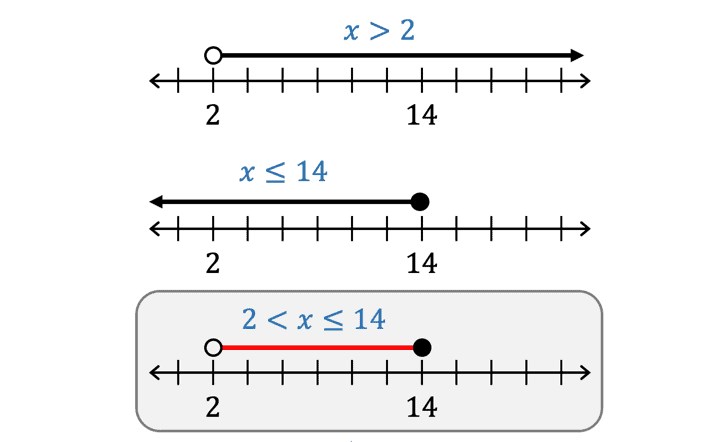
For \(x \le 14\), we read it as “x is less than or equal to 14“. There is an equality condition, therefore the number 14 is part of the solution, so we’ll close the circle around it. We will draw an arrow to the left of 14 to indicate that all numbers to the left of it are also solutions.
The final solutions will be the intersection or overlap of the two inequalities: \(x \gt 2\) and \(x \le 14\). All the numbers between 2 and 14 are part of the final solutions to the “and” compound inequality. We add the number 14 to the solution set because they intersect at the number 14. However, they do not intersect at point 2, so we drop it as part of the solution. We have just determined the solution set for the given compound inequality.
On the number line, all values of x greater than 2 but less than or equal to 14 are shown as a compound inequality
Step 3: Write the solutions in interval notation.
All numbers between 2 and 14 are included in the solution. Moreover, the number 2 is excluded since it has an open circle, while the number 14 is included since it has a closed circle. As of now, we use a rounded bracket or parenthesis if it is excluded (2 is excluded), and a square bracket if it is included (14 is included).
\(\left( {2,14} \right]\)
This is read as “all the numbers greater than 2 but less than or equal to 14.”
$$\mathit{\color{red}{This\ type\ of\ interval\ is\ also\ known\ as\ half-closed\ or}}$$
$$\mathit{\color{red}{half-open\ interval\ because\ one\ of\ the\ two\ endpoints\ is\ included\ but\ the\ other\ is\ not.}}$$
Solve the compound inequality \(2+3x\gt -10\) and \(2\left( {x – 1} \right) \lt x + 4\). Graph the solution set on the number line. Then, write the solution set in the interval notation.
Step 1: Solve each inequality.
First inequality: \(2 + 3x \gt – 10\)
Inequalities on both sides are subtracted by 2. Divide both sides by 3.
$$2 + 3x \gt – 10$$
$$2 – 2 + 3x \gt – 10 – 2$$
$$3x \gt – 12$$
$$\frac{3x}{3} \gt \frac{-12}{3}$$
$$x\gt −4$$
Second Inequality: \(2\left( {x – 1} \right) \lt x + 4\)
Distribute the 2 to the binomial inside the parenthesis. Add 2 on both sides by of the inequality. Then subtract both sides by x.
$$2\left( {x – 1} \right) \lt x + 4$$
$$2x – 2 \lt x + 4$$
$$2x – 2 + 2 \lt x + 4 + 2$$
$$2x \lt x + 6$$
$$2x – x \lt x – x + 6$$
$$x \lt 6$$
The solutions are given by \(x\gt −4\) and \(x \lt 6\).
Step 2: Graph the solution set on the number line.
Strict inequality is a type of inequality that is either absolutely greater than a number, \(x\gt a\), or absolutely lesser than a number, \(x\lt a\). You will notice that strict inequality does not contain an equality component.
On the other hand, the inequality symbol \(x \ge a\) which is read as “x is greater than or equal to a, and the inequality symbol \(x \le a\) which is read as “x is less than or equal to a” are both non-strict inequalities because they have the equality conditions.
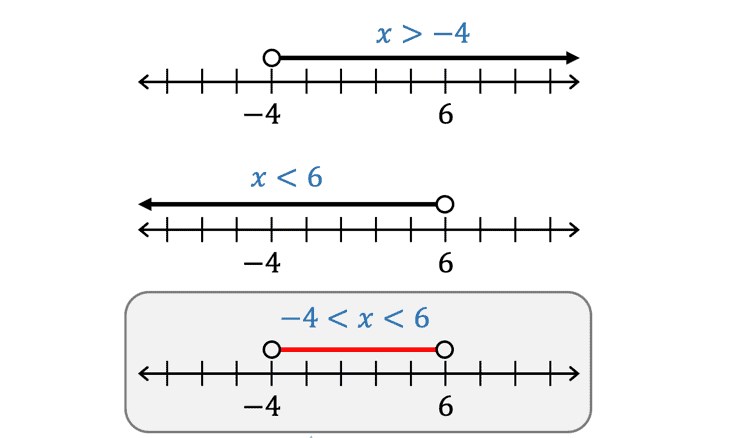
The inequality \(x\gt −4\) is a strict inequality therefore we will put an open circle over -4 as it is not part of the solutions, and draw an arrow to the right. Similarly, \(x\lt 6\) is a strict inequality thus we will put an open circle over 6, and draw an arrow to the left.
The final solution set will be the intersection of \(x\gt −4\) and \(x\lt 6\) which are all the numbers between −4 and 6 but excluding the endpoints -4 and 6.
Step 3: Write the solutions in interval notation.
On both sides, we will use rounded brackets or parentheses to indicate that both endpoints are excluded from the solution set.
$$\left( {-4,6} \right)$$
It is read as “all the numbers greater than -4 but less than 6.
\(\mathit{\color{red}{This\ type\ of\ interval\ is\ also\ known\ as\ an\ open\ interval\ because\ the\ two\ endpoints\ are}}\)
\(\mathit{\color{red}{excluded\ in\ the\ solution\ set.\ That\ is,\ they\ are\ NOT\ part\ of\ the\ solutions.}}\)
Solve the compound inequality \(5 – 3\left( {x – 2} \right) \le x – \left( { – 2x + 13} \right)\) and \(5 – \left( {x + 1} \right) \le 2\left( {7 – x} \right) + 1\). Graph the solution set then write its solutions in the interval notation.
Step 1: Solve each inequality.
First inequality: \(5 – 3\left( {x – 2} \right) \le x – \left( { – 2x + 13} \right)\)
Using the Distributive Property of Multiplication over Addition, remove the parenthesis from each side of the inequality. Put 5 and 6 on one side of the inequality. Subtract 1 from both sides. Subtract both sides by 3x. Divide both sides by -6. As we divide each side by a negative number, we will switch the direction of the inequality. Hence, “from less than or equal to” to “greater than or equal to”.
$$5 – 3\left( {x – 2} \right) \le x – \left( { – 2x + 13} \right)$$
$$5 – 3x + 6 \le x + 2x – 13$$
$$- 3x + 11 \le 3x – 13$$
$$- 3x + 11 – 11 \le 3x – 13 – 11$$
$$- 3x \le 3x – 24$$
$$- 3x -3x \le 3x – 3x+24$$
$$- 6x \le-24$$
$$\frac{- 6x}{-6} \le \frac{-24}{-6}$$
$$x \ge 4$$
Second Inequality: \(5 – \left( {x + 1} \right) \le 2\left( {7 – x} \right) + 1\)
Using the Distributive Property of Multiplication over Addition, remove the parentheses. Subtract 5 by 1 on the left side. Add 4 to both sides of the inequality. Add 2x to both sides to finish it off.
$$5 – \left( {x + 1} \right) \le 2\left( {7 – x} \right) + 1$$
$$5 – x – 1 \le 14 – 2x + 1$$
$$4 – x \le 15 – 2x$$
$$4 – 4 – x \le 15 – 4 – 2x$$
$$- x \le 11 – 2x$$
$$- x + 2x \le 11 – 2x + 2x$$
$$x \le 11$$
The solutions are given by \(x \ge 4\) and \(x \le 11\).
Step 2: Graph the solution set on the number line.
For \(x \ge 4\), we will shade the circle above 4 to show that it is included in the solutions because the inequality has a condition of equality, that is, “greater than or equal to”. The arrow points to the right of 4 since it has a component of “greater than”.
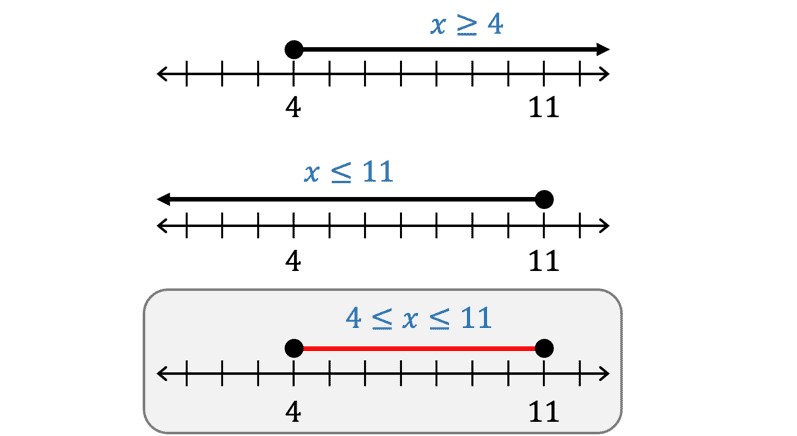
For \(x \le 11\), we will also shade the circle above 11 to indicate that is it is part of the solution set since the inequality has a condition of equality, that is, “less than or equal to”. Due to the case of less than, the arrow points to the left of 11.
In the final solution set, we find all the points where the two inequalities intersect. It is obvious that they intersect between 4 and 11. They also overlap at the endpoints. Accordingly, the final solution set contains all the points between endpoints 4 and 11 and includes the endpoints.
Step 3: Write the solution set in interval notation.
Square brackets will be used on both sides to indicate that both endpoints are included in the solution set.
$$\left[ {4,11} \right]$$
It is read as “all numbers greater than or equal to 4 but less than or equal to 11.
\(\mathit{\color{red}{This\ type\ of\ interval\ is\ also\ known\ as\ a\ closed\ interval\ because\ the\ two\ endpoints\ are}}\)
\(\mathit{\color{red}{included\ in\ the\ solution\ set.\ That\ is,\ they\ are\ part\ of\ the\ solutions.}}\)
Solve the compound inequality \(3x – 2\left( {1 – x} \right) \lt x – 6\) and \(10 – x \lt x + 2\). Graph the solution set then write its solutions in the interval notation.
Step 1: Solve each inequality.
First inequality: \(3x – 2\left( {1 – x} \right) \lt x – 6\)
Remove the parenthesis by distributing the -2 into the binomial 1-x on the left side of the inequality. Also, add 3x and 2x to the left side. Divide by 2 into both sides. Subtract x from both sides. Divide by 4 into both sides.
$$3x – 2\left( {1 – x} \right) \lt x – 6$$
$$3x – 2 + 2x \lt x – 6$$
$$5x – 2 \lt x – 6$$
$$5x – 2 + 2 \lt x – 6 + 2$$
$$5x \lt x – 4$$
$$5x – x \lt x – x – 4$$
$$4x \lt – 4$$
$$\frac{4x}{4}\lt \frac{-4}{4}$$
$$x \lt -1$$
Second inequality: \(10 – x \lt x + 2\)
Subtract both sides of the inequality by 10. Then, subtract it also on both sides by x. Finally, divide each side by -2. Since we are dividing by a negative number, we must flip or switch the direction of the inequality symbol. In this case, from less than to greater than.
$$10 – x \lt x + 2$$
$$10 – 10 – x \lt x + 2 – 10$$
$$- x \lt x – 8$$
$$- x – x \lt x – x – 8$$
$$- 2x \lt – 8$$
$$\frac{-2x}{- 2}\gt \frac{-8}{-2}$$
$$x \gt 4$$
Observe that the solutions of the two inequalities \(x \lt- 1\) and \(x \gt 4\) do not intersect, and thus the compound inequality has no solution.

Their graphs on the number line make it more obvious that they do not overlap.
The “OR” Compound Inequalities
Solve the compound “or” inequality by solving each of the two inequalities separately. For the “or” case, we want to find all the numbers that can make at least one of the two inequalities to be true.
Solve the compound inequality \(2x – 5 \gt 3x + 2\) or \(x – 1 \lt 2x – 5\). Graph the solutions on the number line. Then, write your solutions in interval notation.
Step 1: Solve each inequality.
Add 5 to both sides of the inequality. Then subtract 3x on both sides. Finally, divide -1 into both sides. Don’t forget to flip the inequality symbol because we divided a number by a negative number.
First inequality: \(2x – 5 > 3x + 2\)
$$2x – 5 + 5 > 3x + 2 + 5$$
$$2x > 3x + 7$$
$$2x – 3x > 3x – 3x + 7$$
$$-x > 7$$
$$\frac{-x}{- 1} < \frac{7}{-1}$$
$$x < – 7$$
Second inequality: \(x – 1 < 2x – 5\)
Add both sides by 1. Then subtract by 2x to both sides. Divide both sides of the inequality by -1 thus switching the direction of the inequality symbol.
$$x – 1 < 2x – 5$$
$$x – 1 + 1 < 2x – 5 + 1$$
$$x < 2x – 4$$
$$x – 2x < 2x – 2x – 4$$
$$- x < – 4$$
$$\frac{-x}{-1} > \frac{4}{-1}$$
$$x > 4$$
The solutions are given by \(x < – 7\) or \(x > 4\).
Step 2: Graph the solution set on the number line.
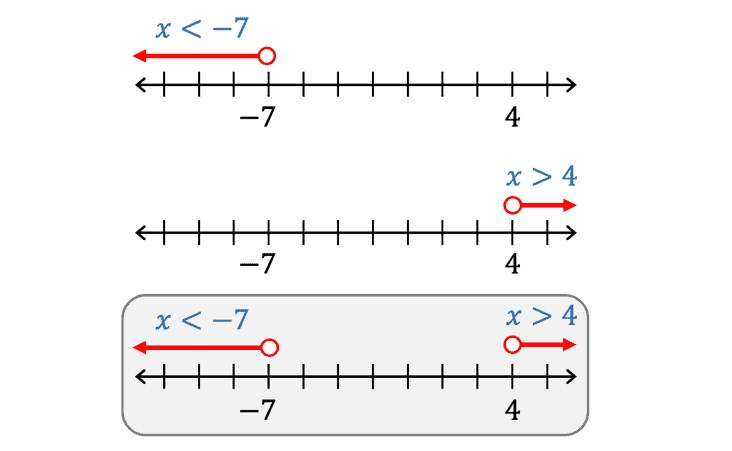
Step 3: Write the solutions in interval notation.
\(\left( { – \infty ,7} \right) \cup \left( {4,\infty } \right)\)
It is as read as “all numbers less than negative 7 or all numbers greater than 4.
Solve the compound inequality \(2\left( {x + 1} \right) \le x – 2\) or \(3\left( {x – 1} \right) \le 4x – 3\). Graph the solutions on the number line. Then, write your solutions in interval notation.
Step 1: Solve each inequality.
First inequality: \(2\left( {x + 1} \right) \le x – 2\)
Distribute 2 into the quantity (x+1). Subtract 2 on both sides of the inequality. Finally, subtract xx on both sides to get to the final solution.
Second inequality: \(3\left( {x – 1} \right) \le 4x – 3\)
Distribute 3 into the quantity \((x-1)\). Next, add 3 to both sides of the inequality. Then, subtract sides by 4x. Finally divide both sides by -1. Please don’t forget to switch the direction of the inequality from “less than or equal to” to “greater or equal to”.
The solutions are given by \(x \le – 4\) or \(x \ge 0\).
Step 2: Graph the solution set on the number line.
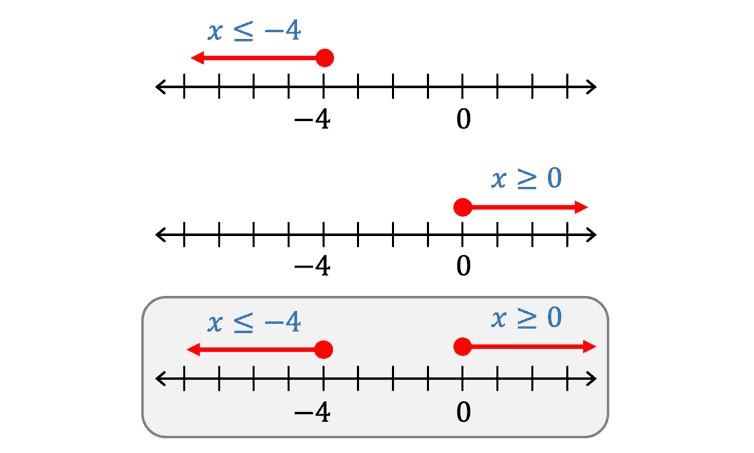
Step 3: Write the solutions in interval notation.
\(\left({ – \infty , – 4} \right) \cup \left( {0,\infty } \right)\)
It is read as “all numbers less than or equal to -4 or all numbers greater than or equal to 0.
Solve The Compound Inequality Calculator:
This topic refers to a calculator that can solve compound inequalities. You can explain the concept of compound inequalities, how they differ from simple inequalities, and provide step-by-step instructions on using the calculator. Additionally, you could include an example problem and demonstrate the calculator’s usage to solve it.
Example: “Solving the compound inequality 2x + 3 > 7 and x – 5 < 10 can be challenging, but with our Compound Inequality Calculator, you can find the solution in seconds. Let’s consider an example: 2x + 3 > 7 and x – 5 < 10. By plugging in the values and following the steps outlined in our calculator, we can determine the solution and display it in an easily understandable format.”
Compound Inequality To Interval Notation Calculator:
This topic relates to a calculator that converts compound inequalities into interval notation. Provide an explanation of interval notation and demonstrate how the calculator performs the conversion. Include an example problem and guide users through the process of converting the compound inequality to interval notation using the calculator.
Example: “Converting compound inequalities to interval notation is essential in mathematics. Our Compound Inequality to Interval Notation Calculator simplifies this process. For instance, let’s consider the compound inequality 3x + 2 < 8 or 5x – 7 > 15. By inputting the equation into our calculator and following the provided steps, we can convert the compound inequality into interval notation, which helps express the solution more clearly.”
Compound Inequality Calculator Number Line:
This topic refers to a calculator that utilizes a number line to solve compound inequalities. Explain how a number line can visually represent the solution to a compound inequality and how the calculator simplifies the process. Provide an example problem and guide users through the steps of solving it using the number line calculator.
Example: “Our Compound Inequality Calculator with a Number Line feature provides a visual representation of the solution. Let’s solve the compound inequality 4x + 5 ≤ 25 and 3x – 7 > 10 using our calculator. By inputting the equation and following the provided instructions, the calculator will generate a number line graph, indicating the solution region and helping you understand the solution more intuitively.”
Compound Inequality Calculator With Steps:
This topic refers to a calculator that not only provides the solution to compound inequalities but also includes step-by-step explanations. Emphasize the importance of understanding the solution process and provide an example problem. Guide users through the calculator’s steps to solve the compound inequality while offering explanations at each stage.
Example: “Understanding the step-by-step process is crucial when solving compound inequalities. Our Compound Inequality Calculator with Steps breaks down the solution process to enhance your comprehension. Let’s consider the compound inequality 2x – 5 < 15 and 3x + 4 > 10. By inputting the equation into our calculator and following the provided steps, you’ll not only get the solution but also gain a deeper understanding of how it’s obtained.”
Compound Inequality Calculator Interval Notation:
This topic focuses on a calculator that directly provides the solution to compound inequalities in interval notation format. Explain the significance of interval notation and how it simplifies the representation of the solution. Include an example problem and guide users through the calculator’s steps to obtain the interval notation solution.
Example: “Our Compound Inequality Calculator in Interval Notation format offers a straightforward solution representation. Let’s solve the compound inequality 2x +
3 ≤ 9 or 4x – 6 > 14 using our calculator. By inputting the equation and following the provided instructions, the calculator will deliver the solution in interval notation, making it easier to understand and work with.”
System Of Inequalities Calculator:
This topic relates to a calculator that solves systems of inequalities. Explain the concept of systems of inequalities, how they differ from single inequalities, and the importance of finding the solution region. Provide an example system of inequalities and guide users through the calculator’s steps to find the solution.
Example: “Solving systems of inequalities is a common task in mathematics. Our System of Inequalities Calculator streamlines this process. For example, let’s solve the system of inequalities 2x + y ≤ 10, 3x – y > 4. By entering the equations into our calculator and following the provided instructions, you can quickly find the solution region, allowing you to visualize the possible values for x and y.”
How To Solve Compound Inequalities:
This topic involves providing a detailed explanation of how to solve compound inequalities manually. Include an overview of the process, highlighting the different scenarios such as “and” and “or” compound inequalities. Provide step-by-step instructions and examples to help users understand the solution process.
Example: “Solving compound inequalities involves understanding the different scenarios that ‘and’ and ‘or’ compound inequalities present. To solve compound inequalities manually, you need to follow specific steps. Let’s consider the compound inequality 2x – 5 < 15 and 3x + 4 > 10. We’ll guide you through the step-by-step process, illustrating how to isolate x and obtain the solution for both inequalities.”
Inequality Solver Step By-step:
This topic focuses on providing a comprehensive step-by-step guide to solving inequalities. Explain the different types of inequalities and their solution processes, such as linear, quadratic, and absolute value inequalities. Provide detailed instructions, examples, and explanations to help users solve inequalities step by step.
Example: “Solving inequalities requires a systematic approach, and understanding the process is vital. Our Inequality Solver Step By-step guide provides a comprehensive overview. Let’s solve a linear inequality, for example, 3x + 4 > 10. We’ll guide you through each step, including isolating x, simplifying the equation, and interpreting the solution correctly.”
FAQs
What is compound inequality give some examples?
Compound inequalities are the derived form of inequalities, which are very useful in mathematics whenever dealing with a range of possible values. For example, after solving a particular linear inequality, you get two solutions, x>3 and x<12. You can read it as “3 is less than x, which is less than 12.
What is a compound inequality and how is it solved?
A compound inequality contains at least two inequalities that are separated by either “and” or “or”. The graph of a compound inequality with an “and” represents the intersection of the graph of the inequalities. A number is a solution to the compound inequality if the number is a solution to both inequalities.
Are compound inequalities AND or OR?
A compound inequality is a sentence with two inequality statements joined either by the word “or” or by the word “and.” “And” indicates that both statements of the compound sentence are true at the same time. “Or” indicates that, as long as either statement is true, the entire compound sentence is true.
How do you tell if it is an AND or OR inequality?
If it is a conjunction that uses the word and, the solution must work in both inequalities and the solution is in the overlap region of the graph. If it is a disjunction that uses the word or, the solution must work in either one of the equations.
What inequality has no solution?
Here are the steps to follow when solving absolute value inequalities: Isolate the absolute value expression on the left side of the inequality. If the number on the other side of the inequality sign is negative, your equation either has no solution or all real numbers as solutions.
What Is The Interval Notation For The Compound Inequality Calculator?
The Interval Notation for the Compound Inequality Calculator refers to the capability of the calculator to provide the solution to compound inequalities in interval notation format. Interval notation represents the solution set using intervals on the number line. For example, if the solution to a compound inequality is x ∈ (-∞, 3] ∪ (5, ∞), the interval notation signifies that x can take any value less than or equal to 3, excluding 5.
How To Find The Solution Set Of A Compound Inequality Calculator?
To find the solution set of a compound inequality using a calculator, follow these steps:
1. Input the compound inequality into the calculator.
2. Follow the instructions provided by the calculator.
3. The calculator will process the inequality and determine the solution set.
4. The solution set will be displayed, usually in interval notation or a graphical representation.
By using a compound inequality calculator, you can obtain the solution set accurately and efficiently without manual computations.
What Is The Solution To The Compound Inequality Calculator?
The solution to the compound inequality calculator refers to the output generated by the calculator, which represents the solution set of the given compound inequality. The solution may be expressed in different formats, such as interval notation, graphical representation, or a list of values that satisfy the inequality. The exact form of the solution depends on the capabilities of the specific calculator being used.
What Is The Solution To The Compound Inequality In Interval Notation Calculator?
The solution to the compound inequality in interval notation calculator provides the solution set of the compound inequality using interval notation. Interval notation is a concise and standardized way of representing the solution set using intervals on the number line. The calculator will typically display the solution set as a combination of intervals, which may be open or closed on either end. For example, a solution in interval notation might look like [-2, 5) ∪ (7, 10].
How Do I Change X – 10 < 0.1 Into A Compound Inequality Calculator?
To convert the equation “x – 10 < 0.1” into a compound inequality using a calculator, follow these steps:
1. Subtract 0.1 from both sides of the equation: x – 10 – 0.1 < 0.1 – 0.1 simplifies to x – 10 < 0.
2. The resulting inequality is now x – 10 < 0.
3. Input this inequality into the compound inequality calculator.
4. Follow the instructions provided by the calculator to obtain the solution set for the compound inequality.
The compound inequality calculator will process the inequality and determine the appropriate solution set based on the input.
